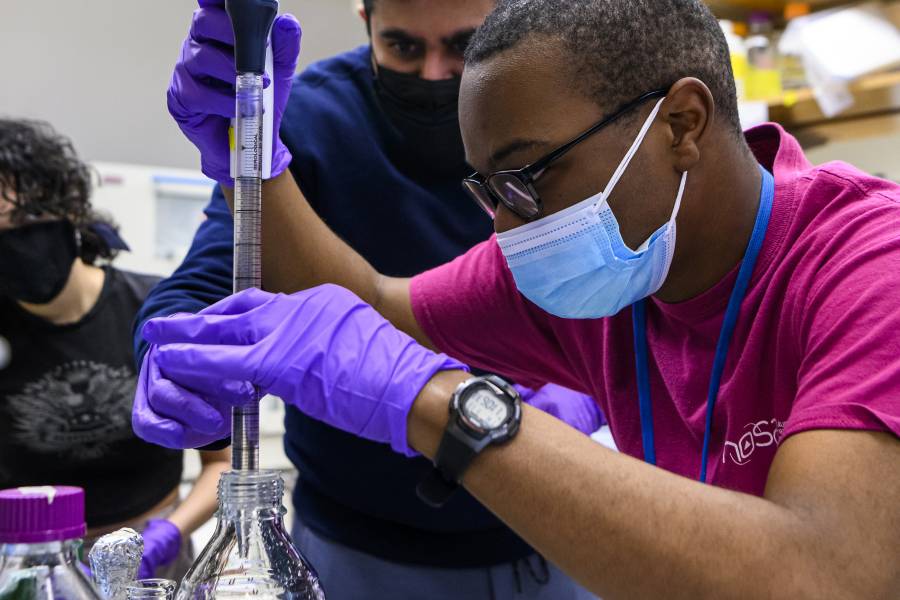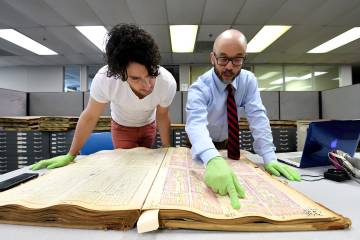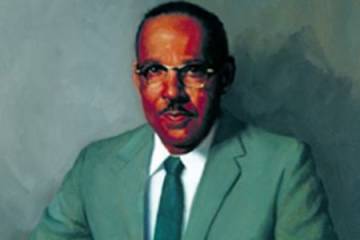Chemist Stephen Fried gets a lot of emails from students asking to work in his lab or do a research placement with him, and he's noticed a pattern. "They generally come from pretty advantaged backgrounds," says Fried, assistant professor in the Department of Chemistry.
The reasons are pretty clear, he adds. Students without parents or other mentors who have backgrounds in higher education have not often heard the message that they can just email a professor with such a request, while others have been preparing to take that initiative for years. The gap compounds as the more advantaged students chart a course through research experience, publications, letters of recommendation, and—eventually—graduate or medical school acceptances.
"There are a lot of advantages that are accrued from taking that initial step and putting oneself out there that I don't think all students are aware of, or at least not at the beginning," Fried says.

Image caption: Early in the course, students learned basic lab skills, such as how to correctly use a pipette, before growing their own bacteria to study protein folding.
Image credit: Will Kirk / Johns Hopkins University
To try to make research more accessible to first-generation college students and those whose backgrounds are under-represented in STEM fields, Fried created a program in his lab for six first-year students to work on a protein-folding project during Intersession. Launched as a National Science Foundation-sponsored program called FiGURE (first-generation undergraduate research experience), the idea was to create a cohort of students gaining experience with hands-on research, and to build both their confidence as researchers and the tools necessary for them to take the next steps in whatever direction they choose.
"It's definitely opened a door for me I didn't know existed," says participant Muhammad Bennani, who plans to major in molecular and cellular biology.
After a few preliminary sessions together during the fall semester, Bennani and the others spent just under four weeks testing a theory that Fried's lab was working on. Proteins—the molecules inside cells that keep the cells running—need to have specific, three-dimensional shapes to perform their functions. But the information that creates proteins is not 3D; it's the linear DNA sequence that we may be familiar with as a string of amino acids labeled as As, Cs, Gs, and Ts. The late Hopkins biochemist Christian Anfinsen shared the 1972 Nobel prize for discovering that the protein's precise shape is fully encoded in its sequence of amino acids, which is in turn encoded by DNA.
But Fried's lab, working with the bacterium E. coli, had found that Anfinsen's discovery only holds true for simple proteins, and that as proteins become larger and more complicated, they lose that ability to shape themselves from their amino acids. Instead, other things in the cell must guide their folding into the correct shapes. The discovery has implications for age-related diseases like Alzheimer's and Parkinson's, which are increasingly believed to be caused by proteins not folding properly, Fried says.
So, Fried tasked the FiGURE students with testing whether his lab's discovery holds true across other bacteria. He asked each student to select a bacterium to work with, figure out how to culture and grow it, and use the lab's protocol to find out whether that bacterium's more complicated proteins need help from the cell to create their proper shapes.

Image caption: Stephen Fried (right) says students gained a more nuanced understanding of their research over the course of the Intersession class.
Image credit: Will Kirk / Johns Hopkins University
With its blend of structure (the existing protocol) and real science ("the results could be publishable, because it hasn't been done before," Fried says), the approach fit the vision Fried had for a meaningful undergraduate research experience. He has mixed memories of his own undergraduate research days, when he says he sometimes felt like a hanger-on if the graduate student he was assigned to was too busy for in-depth mentoring.
"I remember not always feeling part of the team, which is a really important part of science," he says. "You need enough structure that students feel comfortable working on an actual project, while also allowing for trial and error and self-discovery. It's a hard balance to strike."
Fried worked with Calvin Wise, director of recruitment in Undergraduate Admissions, and Ashley Broomes, assistant director of student development for the Johns Hopkins Underrepresented in Medical Professions, or JUMP, program at the Center for Student Success, to identify candidates for his program. He learned that the admissions program tracks first-generation, limited income, and underrepresented students who indicate an interest in pre-med, and the team sent an application to that pool of students over the summer. To his surprise, 50 responded.
Fried and Broomes interviewed 12 applicants to fill the six funded spots, being careful to select them based not on how much experience they'd had, but on criteria like how excited they were about science. Center for Student Success staff had also pointed out that unpaid internships favor students from higher socioeconomic backgrounds who may not need to work during breaks between semesters, so Fried requested additional funds from the NSF to pay his students, and received them.
"There's a lot of interest in supporting this work," he notes.
Madelynn Piona, who is planning to major in public health studies, chose to work with Staphylococcus epidermidis bacteria, which grows on human skin and can cause hospital infections when instruments enter the body. As she watched her bacteria grow and saw evidence of its proteins unfolding and refolding, she realized that she was duplicating in the lab a process that she had just learned about in her General Biology class last semester.
"It was a really cool transition, going from sitting with the textbook and lecture material to now being in a lab setting where we're breaking the bonds we learned how to identify in bio," Piona says.
Bennani, who chose a species of Streptomyces—bacteria that produce more than two-thirds of clinically useful antibiotics of natural origin—had been journaling about his FiGURE experience. Reading back, he realized just how much he learned, and how quickly. "I saw that the first day, we learned to pipette correctly. Now we're out here, our grad student lets us do our thing, and we just come to him for questions," Bennani says.
Intersession's brief timeframe was just long enough for the students to gather data about their bacteria. Now that the session is over, they can choose whether or not to stay in the lab to analyze their results. Either way, Fried hopes to expand the program after showing the model works, and hopes other faculty members join in.
While the ultimate outcome of a program like FiGURE can't be known until the students are several years further into their academic careers, Fried did witness transformation over the few weeks they had together. "You can see the questions they ask are more nuanced, in that process from starting out as a foreigner to a certain field to eventually being able to ask pretty granular questions," he says.
Posted in Science+Technology, Student Life
Tagged chemistry, student experience, first-generation college students, stephen fried










